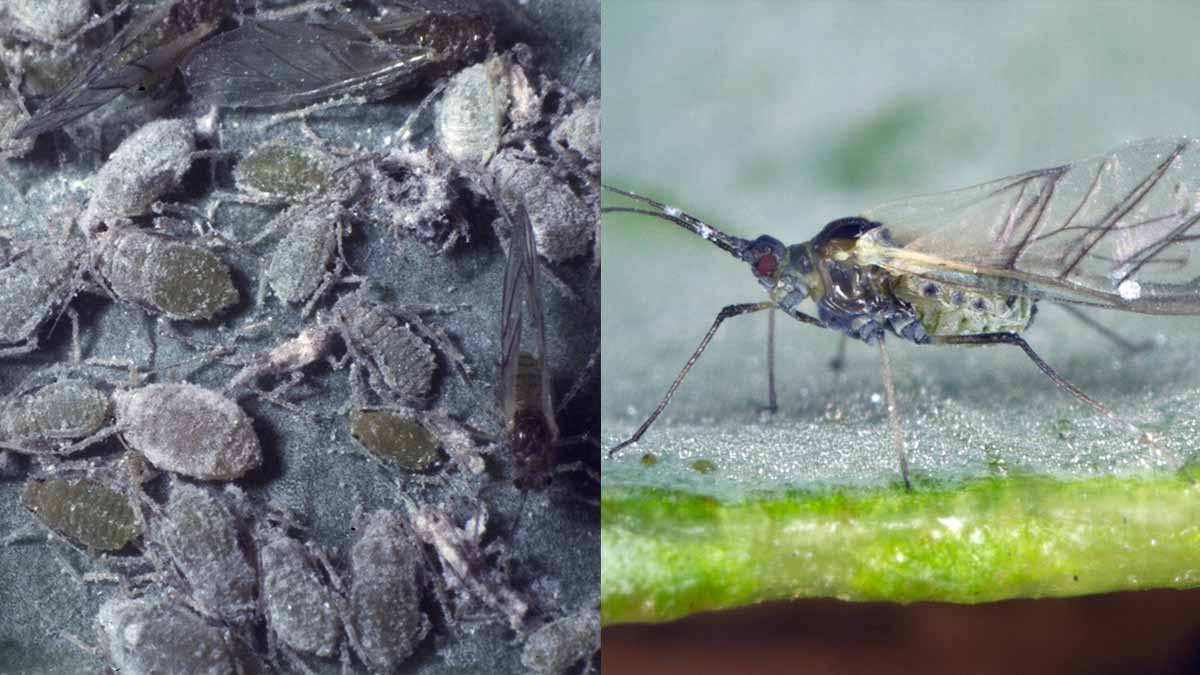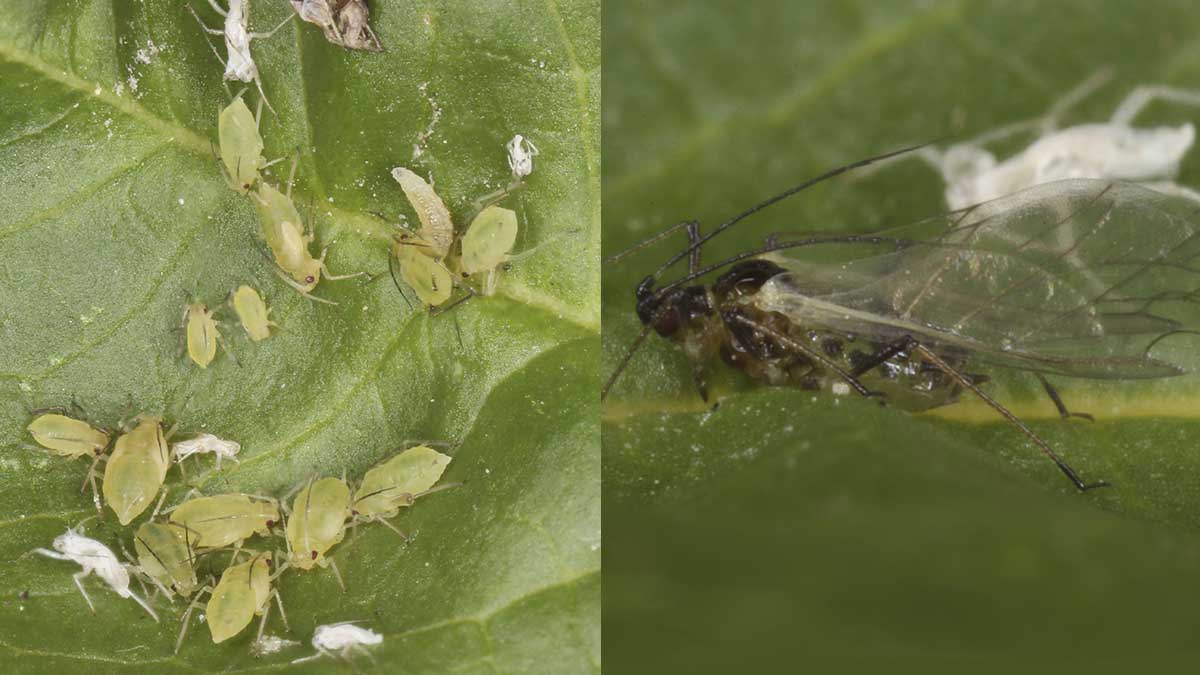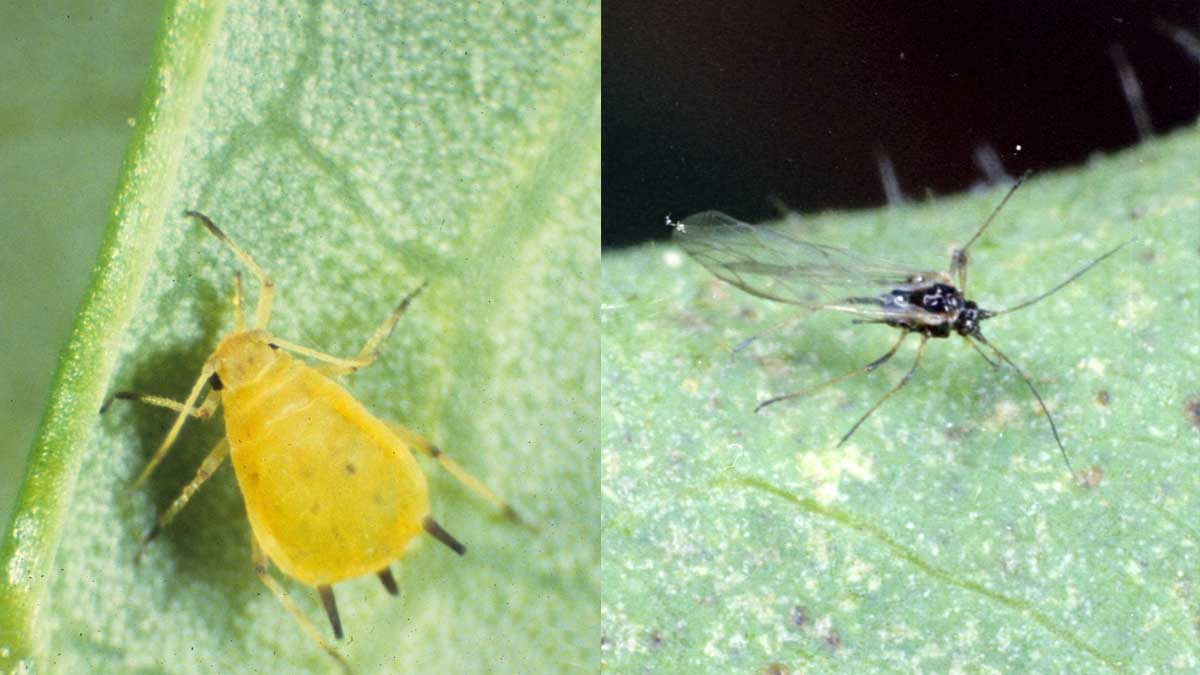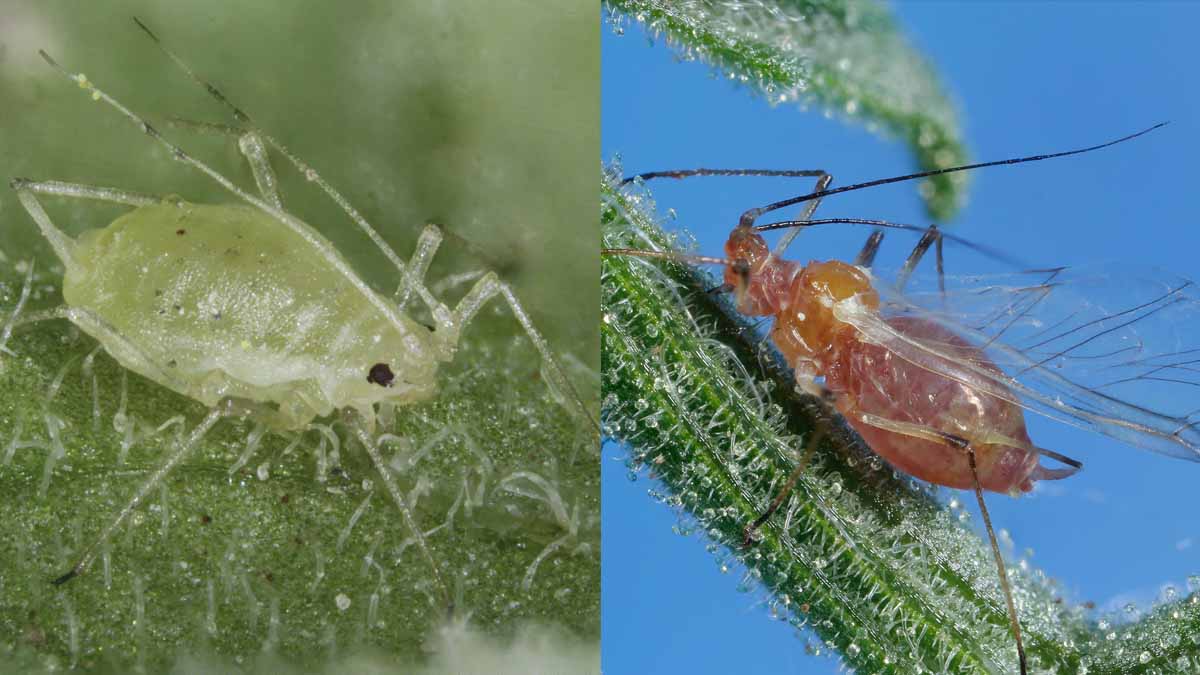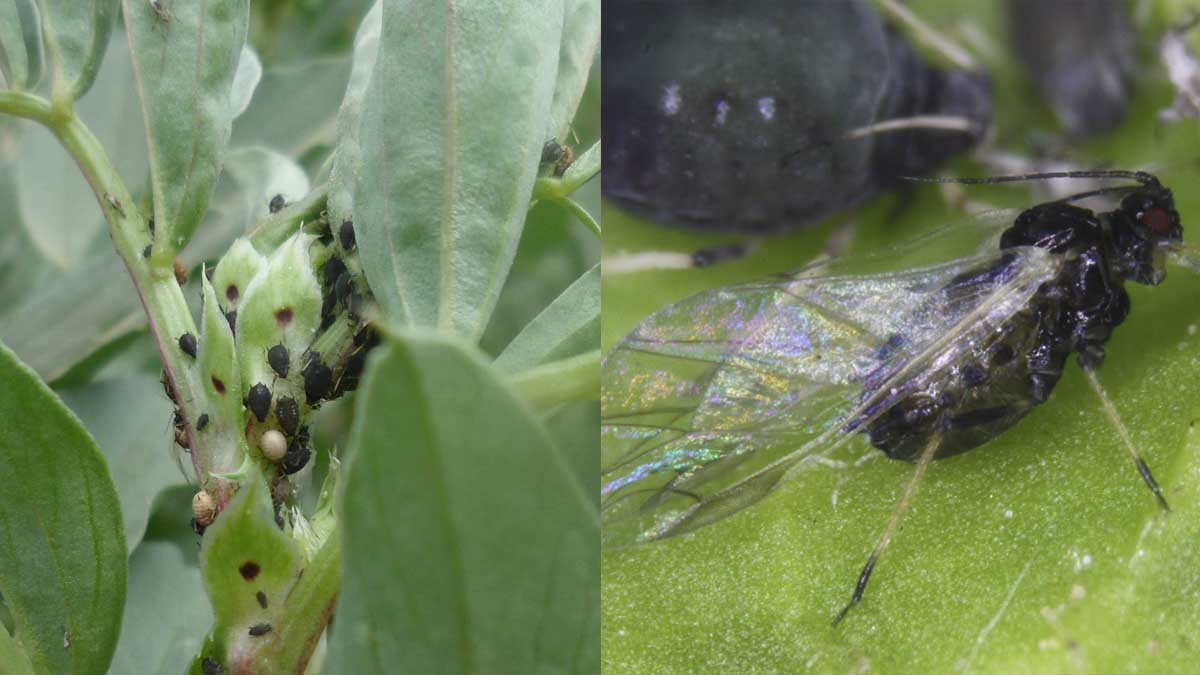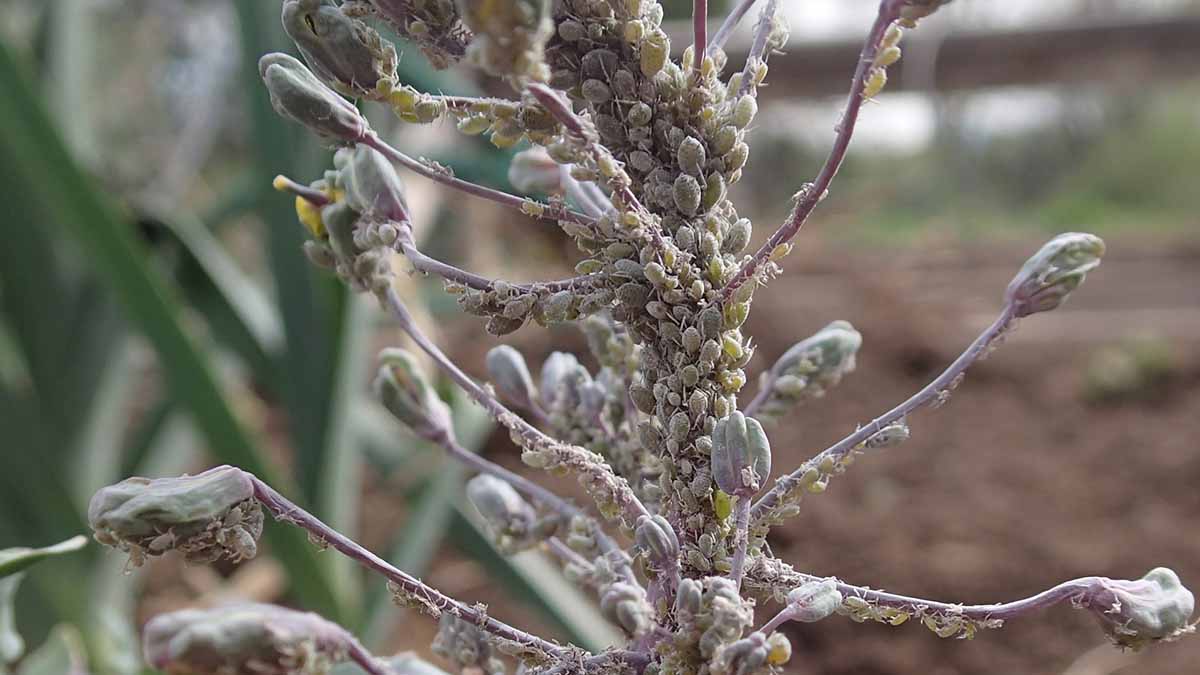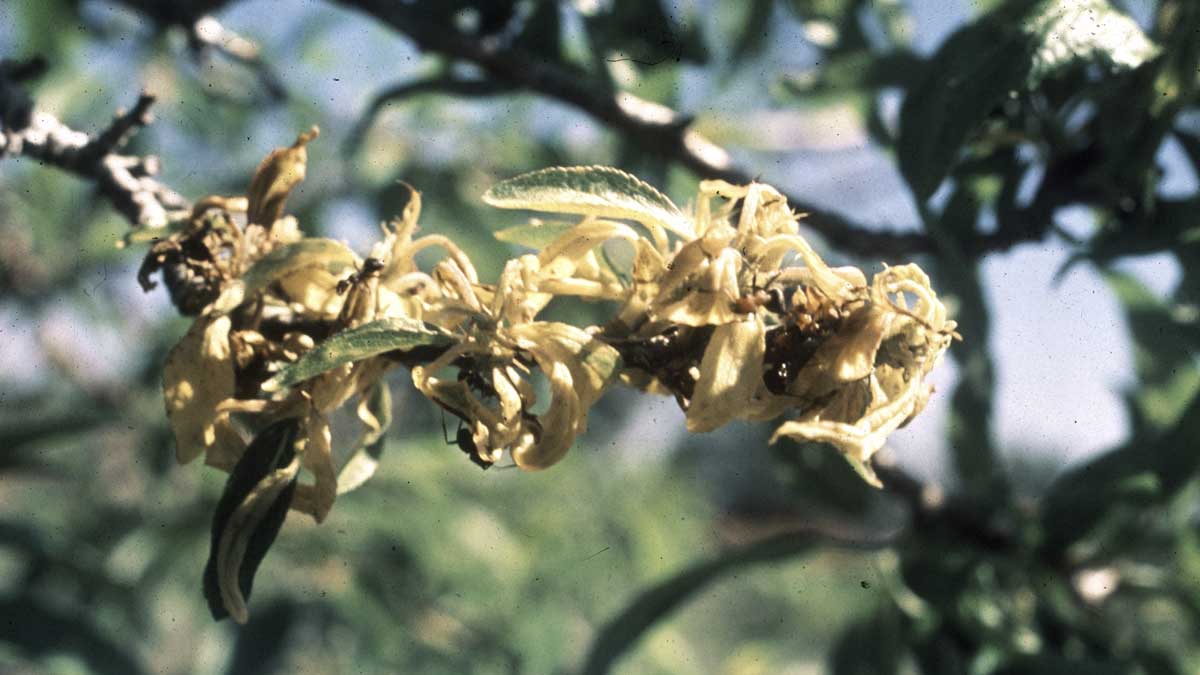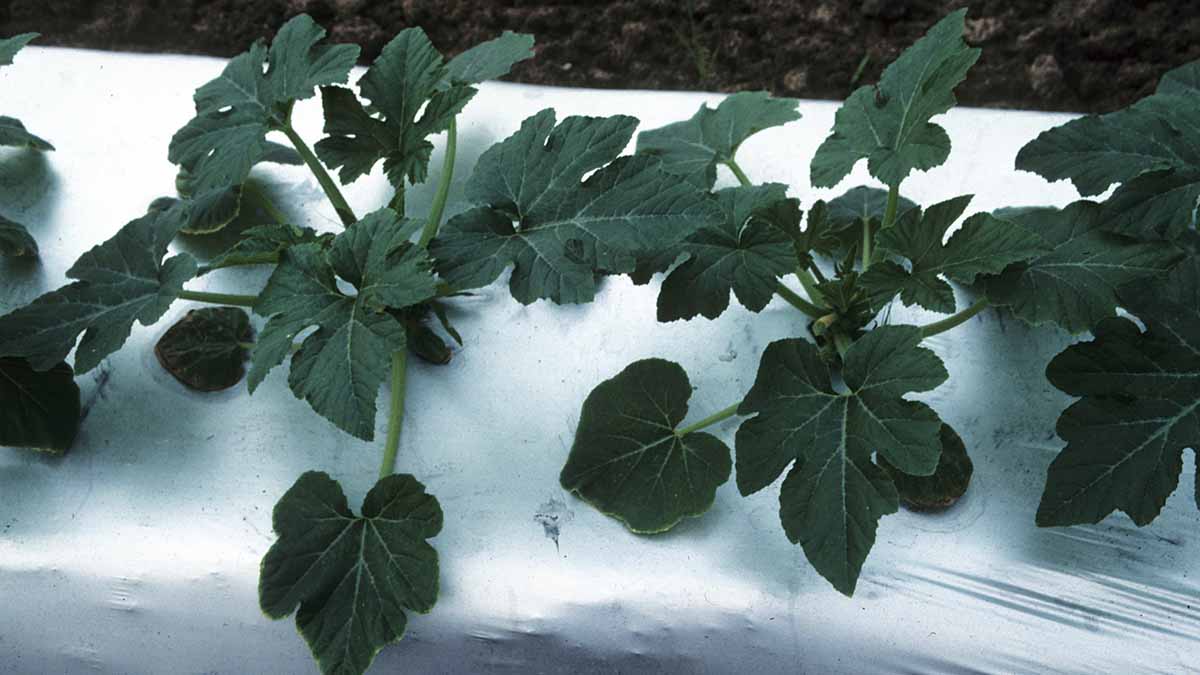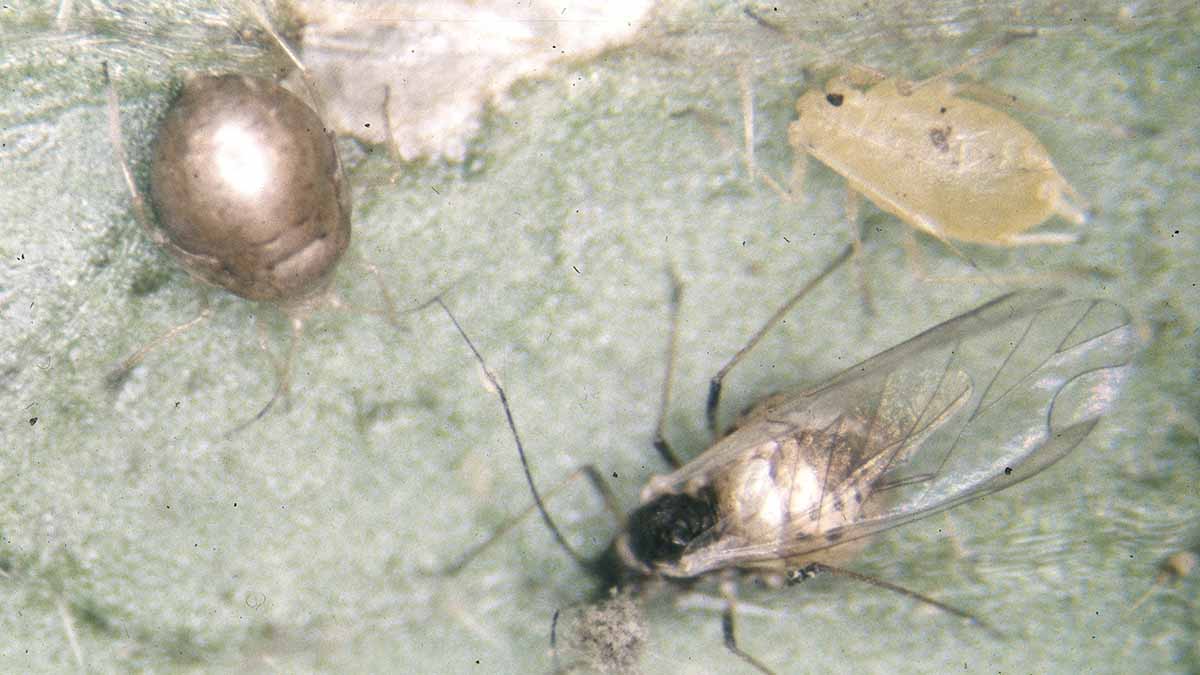Aphids
Pest Common Name
- Cabbage Aphid (Brevicoryne brassicae)
- Corn Leaf Aphid (Rhopalosiphum maidis)
- Green Peach Aphid (Myzus persicae)
- Melon/Cotton Aphid (Aphis gossypii)
- Potato Aphid (Macrosiphum euphorbiae)
- Bean Aphid (Aphis fabae)
- Many others
Cabbage Aphid (Brevicoryne brassicae)
- Winter hosts: Cruciferous plants, both crop residue and weeds
- Summer hosts: Crucifers including broccoli, cabbage, Brussels sprouts, cauliflower and many other mustard family plants; Weeds in the mustard family
Corn Leaf Aphid (Rhopalosiphum maidis)
- Winter hosts: Corn, small grains, oats, crabgrass, foxtail
- Summer hosts: Corn, small grains, oats and others; Weeds including crabgrass and foxtail
Green Peach Aphid (Myzus persicae)
- Winter hosts: Primarily peach and apricot trees
- Summer hosts: Extremely wide host range, including potato, legumes, corn, pepper, tomato, spinach, crucifers, cucurbits, lettuce and many others; Weeds including shepherd’s purse, medic, field bindweed, hairy nightshade, many others
Melon/Cotton Aphid (Aphis gossypii)
- Winter hosts: Catalpa, rose-of-sharon, greenhouse plants
- Summer hosts: Cucumber, melon, squash, eggplant, many shrubs; Weeds including field bindweed, pigweeds, plantain, jimsonweed, milkweed and others
Potato Aphid (Macrosiphum euphorbiae)
- Winter hosts: Rose plants
- Summer hosts: Potato, tomato, legumes, oats, many others; Weeds including nightshades, ragweed, common lambsquarters, pigweed, shepherd’s purse and others
Bean Aphid (Aphis fabae)
- Winter hosts: Woody shrubs, primarily viburnum
- Summer hosts: Many legumes, beets, Swiss chard, potato, crucifers, cucurbits and others; Weeds including wooly burdock, lamb’s quarters, tumbling saltbush, thistles, docks and others
There are dozens of species of aphid in Idaho but they are all generally oval or pear-shaped, soft-bodied and quite small (generally approximately 1/32-1/8 inch (1-3.5 mm). Adult aphids can be either winged or wingless, whereas nymphs (immatures) are always wingless but resemble wingless adults, only smaller. Aphids have piercing/sucking mouthparts that they use to feed on plant sap. Aphids can be differentiated from other small insects by the presence of cornicles, small rear-facing “tailpipe” like appendages near the end of the abdomen, and sometimes by the presence of a sugary secretion called “honeydew” under the aphid colony. Aphids also do not usually move rapidly when disturbed, another trait that can help differentiate them from other small insects they might be confused with such as leafhoppers (Figures 1-6).






Biology
Different aphid species have unique biologies. Some aphids are specialists, only able to feed on a single type of plant. Other aphids are generalists and are able to feed on a wide variety of plants. Often, it is these generalist feeders that are the most significant pests in gardens. Furthermore, while some aphid species remain on a single host plant species year-round, others have different winter host plants versus summer host plants.
Aphid reproduction also differs between species but most species undergo both sexual and asexual reproduction, depending on the time of year. Aphids reproduce rapidly, there will be individuals from multiple generations within a single colony at any one time. Aphids from different generations will look similar, with immature aphids (also called nymphs) just looking like miniature adults. Most often, you will see aphids with no wings, as these form the bulk of aphid colonies you might find on your plants. However, you may also find winged aphids, called alates. These are not a different species, but are produced when colonies grow too large, or when it is necessary to move between summer and winter hosts.
Damage
Aphids feed by piercing plant tissues at leaves, stems, flowers or very occasionally roots. They feed on sap containing vital nutrients and sugars. Usually, garden plants can tolerate low to moderate numbers of aphids without suffering damage. However, aphids can cause damage if their populations become large or if they infest plants at a vulnerable stage, such as the seedling stage.
Aphid feeding damage can manifest as yellowed or curled leaves, and overall distorted growth and plant stunting (Figure 7-8). Aphid infestations can also lead to damage when their sugary excretion, called honeydew, attracts other pests or leads to growth of fungi like sooty mold. Many plants are also susceptible to aphid-transmitted viruses that can cause significant damage and yield loss. Garden plants that are commonly infected include potato, legumes, squash, pumpkin, melon, lettuces, beet and chard. Symptoms differ among viruses but often include yellowing, mottling or curling of leaves and overall plant stunting. Unfortunately, aphid-transmitted viruses can be hard to control once both aphids and virus are present. It takes an aphid only minutes to transmit a virus to a host plant, so insecticides cannot work rapidly enough to avoid spread of virus among susceptible hosts.


Monitoring
When caught early aphid infestations are much easier to manage so check your plants frequently. Scout for aphids at least twice a week, paying particularly close attention during the late spring when populations tend to grow rapidly. Aphids are most often found on leaves but can be on stems and flowers as well. When checking leaves make sure to check the undersides as many aphid species prefer to build colonies there.
When scouting for aphids, look for beneficial insects such as ladybugs, lacewings and syrphid fly larvae, and aphid “mummies” that are a sign that parasitoids are at work (Figure 10). Also look for aphids that have been killed by disease or fungi. These aphids may appear bloated, off-color, flattened to the leaf surface or fuzzy. The presence of predators, parasitoids, disease or beneficial fungi may be sufficient to reduce aphid numbers significantly within a few days, mitigating the need for other control measures.
Management
Primary Management Tactics
Avoiding the use of broad-spectrum insecticides can help maintain populations of natural enemies that keep aphid numbers from reaching damaging levels. When considering the use of more aggressive control measures, remember that mature plants can usually tolerate mild to moderate aphid infestation. However, if more aggressive measures are deemed necessary, consider using strong sprays of water to wash aphids off infested plants or pruning out infested leaves when infestations are highly localized. In cases where other control measures fail, and chemical means are necessary, insecticidal soaps and horticultural oils are usually the best choice to reduce aphid populations without undue risk to beneficial insects.
Physical
- Use seedling covers to reduce damage to young, vulnerable plants and reduce virus transmission
- Use strong sprays of water to knock aphids off plants, when plant sturdiness allows
Cultural
- Before planting, check area for potential sources of aphids including many types of weeds, mustard plants and crabgrass
- Avoid excess fertilization with nitrogen, which fosters aphid population growth
- Silver-colored reflective mulches hinder aphids’ ability to locate plant hosts and have been shown to reduce virus transmission in some susceptible vegetables (Figure 9)
Biological
- Avoid the use of broad-spectrum pesticides to conserve natural enemies of aphids such as:
- Generalist including predators: lady beetles (adults and larvae), lacewing larvae and soldier beetles
- Parasitic wasps that lay their eggs within aphids, where the developing larvae kill the aphid, leaving “mummies” (Figure 10)


Chemical
- Insecticidal soaps, horticultural oils or plant derived oils such as neem oil are the best option for chemical control in most garden situations, and have reduced risks to beneficial insects, people and pets
- Do not apply soaps or oils when plants are drought stressed or temperatures exceed 90 degrees Fahrenheit
- If using synthetic insecticides, keep in mind that:
- Broad spectrum insecticides may remove natural enemies, leading to aphid outbreaks later in the season
- Multiple applications of the same pesticide may lead to insecticide resistance
- Recommendations for pesticides to use in the management of aphids can be found on the PNW Pest Management Handbooks website
Pesticide Warning
Always read and follow the instructions printed on the pesticide label. The pesticide recommendations in this University of Idaho webpage do not substitute for instructions on the label. Pesticide laws and labels change frequently and may have changed since this publication was written. Some pesticides may have been withdrawn or had certain uses prohibited. Use pesticides with care. Do not use a pesticide unless the specific plant, animal or other application site is specifically listed on the label. Store pesticides in their original containers and keep them out of the reach of children, pets and livestock.
Trade Names — To simplify information, trade names have been used. No endorsement of named products is intended nor is criticism implied of similar products not mentioned.
Groundwater — To protect groundwater, when there is a choice of pesticides, the applicator should use the product least likely to leach.
- Figure 1. Alton N. Sparks, Jr., University of Georgia, Bugwood.org (left), David Cappaert, Bugwood.org (right)
- Figure 2. Kansas Department of Agriculture, Bugwood.org
- Figures 3, 5 (left), 6 (right). Erik J. Wenninger, University of Idaho
- Figure 4. Jim Baker, North Carolina State University, Bugwood.org (left), Clemson University, USDA Cooperative Extension Slide Series, Bugwood.org (right)
- Figure 5. Joseph Berger, Bugwood.org (right)
- Figure 6. Mourad Louadfel, Retired, Bugwood.org (left)
- Figures 7, 8, 10. Whitney Cranshaw, Colorado State University, Bugwood.org
- Figure 9. Gerald Holmes, Strawberry Center, Cal Poly San Luis Obispo, Bugwood.org
Desiree Wickwar, Entomologist, IPM Project Manager
2023







